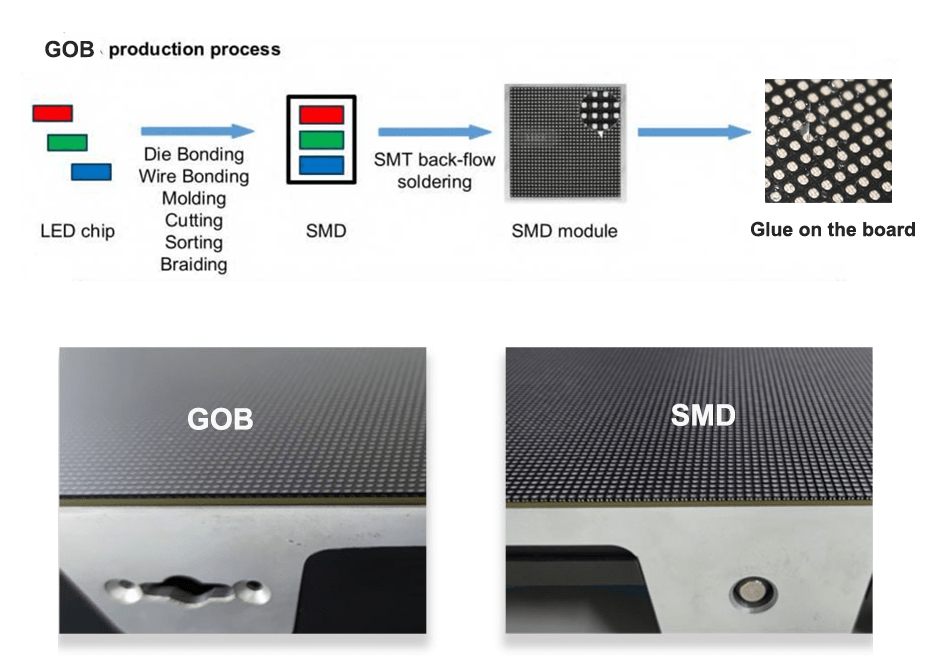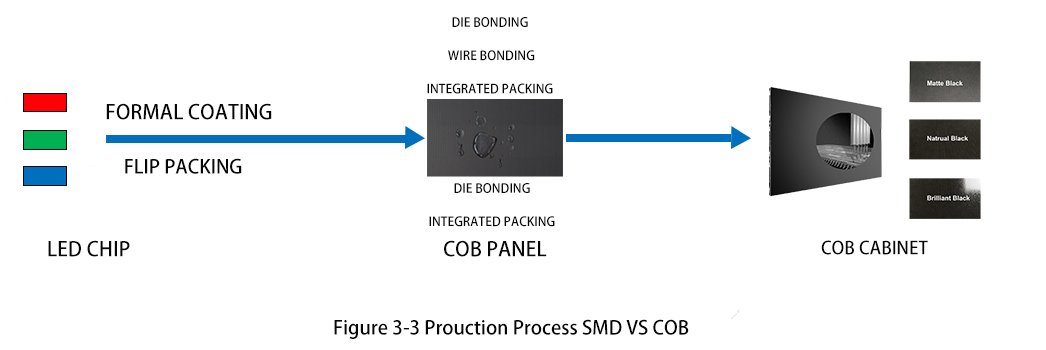COB VS GOB LED DISPLAY
What is GOB
Glue on board is abbreviated as GOB. It is an epoxy resin that is applied to the surface of surface-mounted display modules to create an overall layer of glue that improves the sealing of SMD displays. It is a technology developed to address the issue of LED lamp protection. GOB LED Display is able to work in any challenging environment, making it water-resistant, dust-proof, shock-resistant, and UV-resistant, it is widely used in restaurants, hotels, bars, and Stadio.

GOB VS SMD
GOB LED display technology can be applied in various ways to protect LED displays from damage and reduce maintenance costs. This technology is especially useful for rental LED screens, which are frequently moved and require a high level of protection. such as GOB small-pitch LED displays, GOB flexible LED displays, GOB rental LED displays, GOB floor LED screens, and irregular-shaped GOB LED displays. It can provide waterproof, shockproof, and dustproof protection to ensure that these LED displays remain in good condition.
However, GOB is not a breakthrough in packaging technology, but rather a process improvement to the existing SMD surface mount, which essentially still belongs to the SMD Family. We would rather call it GOM “Glue on Module”.
Compared with SMD, due to the surface coating, GOB’s protection performance has been enhanced, but still fails to improve the display performance.

COB VS GOB
GOB has most of features of the SMD.
1. COB LED screen offers a stunningly high color contrast ratio of 10,000:1, much higher than the regular black SMD LED‘s 5,000:1 contrast ratio. GOB can increast the SMD’s contrast ratio up to 100000:1

2. COB LED modules have a water and moisture-proof rating of IP65 in the front, and IP30 at the back, which allows them to be used even in extreme conditions such as ice water or 100-degree boiling water, providing perfect protection in wet and cold regions, such as Russia.
3. The optical design features a high fill factor and small pixel factor, a “surface light source” emission, a matte coating, a high contrast, reduced glare, and effective resistance to blue light, which can effectively reduce the appearance of moiré. It is particularly suitable for high-end applications such as studios, weather forecast halls, traffic halls, satellite command centers, and broadcasting centers.
4. The COB LED module has an epoxy resin coating on its surface. As the pixel pitch is small, the components are sealed to the PCB, which prevents them from being exposed. This makes the LED display screen resistant to damage and falling off from collisions, as well as being dust-proof, waterproof, moisture-proof, and UV-proof.
6. COB packaging technology has a small pixel density, allowing for an ultra-wide 180° viewing angle. Refraction light losses are minimal, allowing for the same viewing angle experience from any position facing the center of the screen, ensuring consistency of color and brightness no matter the angle.

SMD‘s require reflow soldering, which, when the solder paste reaches a temperature of 240°c, causes an 80% weight loss of the epoxy resin, resulting in the glue easily separating from the LED cup. In contrast, COB technology does not require reflow soldering and thus is more stable. Additionally, solder paste does not need to pass through ROHS approval.

In summary:
1. GOB is not LED chip-level packaging technology, only a 1.0 version of the LED display panel manufacturing technology in the industry chain downstream display factory after the SMT process of a panel protection process.
2. The GOB display panel is an SMD display panel, still can not solve all the problems of the bracket technology.
3. Although the GOB display panel can improve the hard body protection ability and appearance consistency of surface lamp beads, the resulting internal stress release problem, heat dissipation problem, repair problem, adhesive material flame retardant problem, and adhesive affinity problem will deteriorate the working performance of display panel.
4. In actual outdoor cases there has been a large area of cracked glue, peeling, and poor protection performance problems.
GOB is an improvement of traditional SMD technology, it can be used for all pitch displays, and for certain applications that require high-level protection of the LED.
On the other hand, COB display is currently mainly used in the small pitch LED display P0.4~P1.5. This pitch range screen now is also called a Mini LED display. with the decreasing cost of COB. COB technology will be also the mainstream solution for micro-pitch displays in the future.


What’s Happening i’m new to this, I stumbled upon this I’ve found It absolutely useful and it has aided me out loads. I hope to contribute & help other users like its helped me. Great job.
yVFxEkYY5tfPw4q51bkIHVQTDob0oMXwJQeYtewDd2TeCkw69ZCel2dcybv8lzzzqn31g1h08CWB5f6dR7FMy8YImlft28XmKrC04fFBxq3rGprLlcEWRnx85ueMDuIP